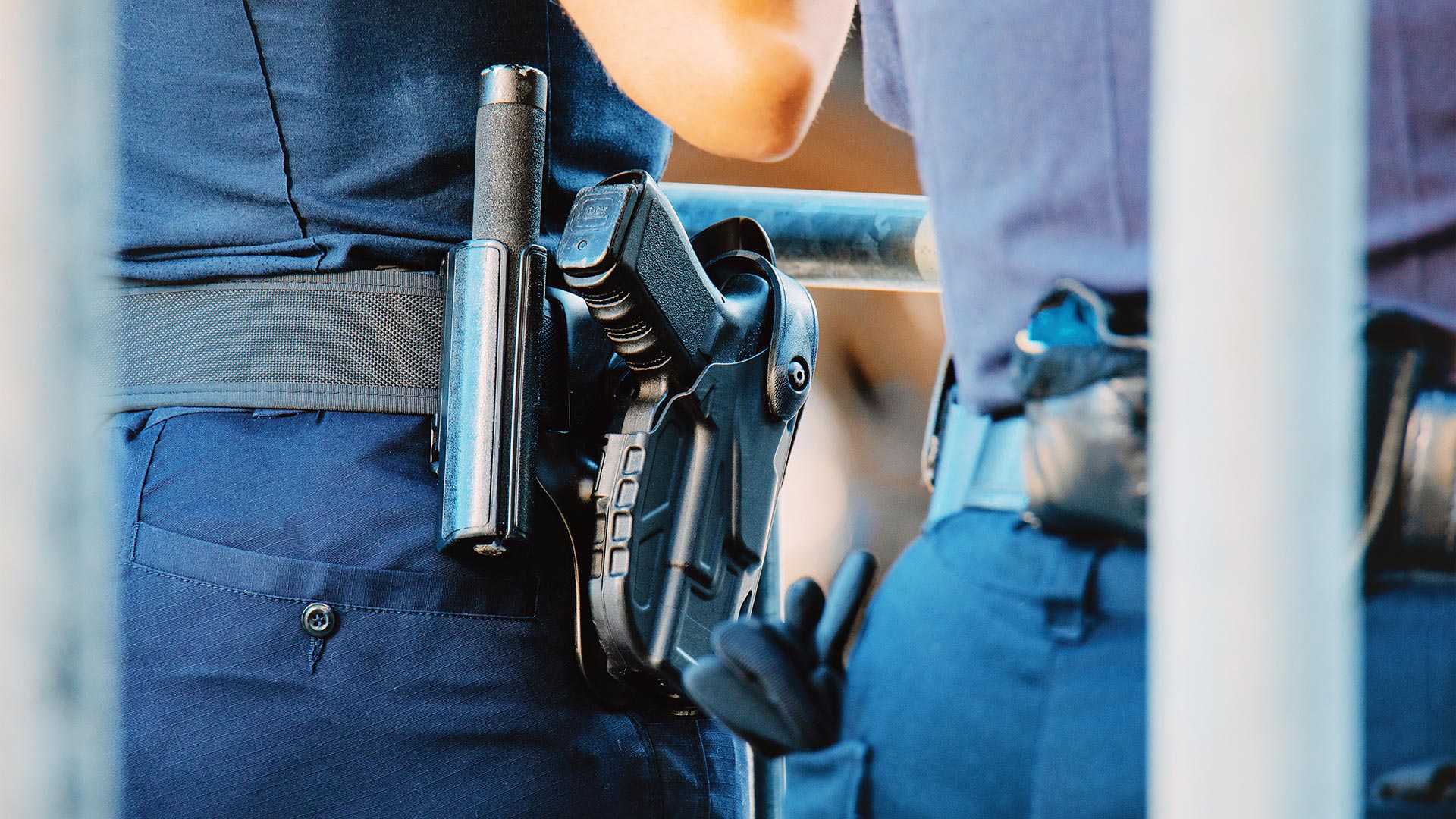
Weapon retention has evolved since the standard leather thumb break holster. Most officers immediately associate the term “weapon retention” with the level of security their duty holster provides. A secure duty holster is a necessary tool in the toolbox for today’s environment. However, so is being prepared for the fight. Weapon retention ultimately starts and ends with the individual officer. The holster is a tool, and although it may prove to be an invaluable tool, it is only as good as the officer using it. When you’re fighting for your gun with a criminal or you need to draw your weapon on someone, it needs to be a quick, smooth and tactical draw from your holster. Our lives depend on tactics. And when it comes to drawing your weapon, officers need more weapon retention training with their holsters for this smooth transition. We are only as good as our training.
Choosing a holster
First and foremost, you need to ensure that the holster is properly secured to your duty rig and the holster is a proper fit for your duty weapon. Although there are exceptions, paddle holsters should be avoided for duty use. The holster mount needs to be securely affixed to the body of the holster and securely attached to the duty belt. Safariland’s mount is extremely durable. It is a hard mount with fixed belt loops, and it mounts to the body of the holster with three hex head screws. Their mounts are available in high-ride, low-ride and mid-ride to adjust the height of the holster. Having the holster at the proper height is obviously important for an efficient draw stroke; however, it is even more important when defending your weapon.
There are career criminals and street gang members who train to defeat these holsters. Are we training as hard as the criminals to get our guns out?
The next step is to look at how the holster operates. Holsters are either a Level 1, 2 or 3. Most agencies today require officers to have a Level 3 duty holster worn by uniformed members of the department while on duty. Every holster manufacturer has its own spin on retention definitions; however, each level of retention is a level of security. Safariland has numerous holsters that operate in many different ways, but its two most popular options for duty holsters are the ALS and SLS offerings. The SLS, or Self-Locking System, utilizes a hood that rotates in and out of place to secure the weapon. The hood must be pushed down and then can be rotated forward and out of the way to draw the weapon. This is considered a Level 2 duty holster. It can be converted to a Level 3 duty holster by adding a sentry lock on the rear of the hood. This is a button that must be manually moved forward, toward the hood, to lock it in place, or away from the hood to release it. This lock prevents the hood from rotating forward when it is engaged. Although the sentry lock works and gets the job done, the demand for Level 3 duty holsters led to the rise of the ALS, or Automatic Locking System, line of holsters from Safariland. These holsters offer the SLS rotating hood with the addition of a button behind the hood that must be released to draw the weapon. These holsters, along with proper training, will release the hood and the button pressed in one smooth, precise and quick movement. The advantage to this system is that once the weapon is placed back in the holster, the SLS hood remains down until the officer manually returns it to the secured position. However, the ALS feature activates and the weapon cannot be removed from the holster unless the button is pressed.
Law enforcement administrators are often asked, what does a Level 3 mean? How do I know if my duty holster is a Level 3? The response is usually “What does it say on the website or package?” It must be understood that agency policies are often made by personnel who have been off the street for a number of years and are relatively out of touch with changes in the industry. It is important to ensure you are always operating within policy, but it is more important to ensure you are operating with duty gear you feel comfortable with. We spoke of Safariland’s offerings because in the law enforcement climate we are associated with this brand, and it is simply the gold standard.
Training
If you have chosen a proper Level 3 duty holster, congratulations — you have covered the easiest, most basic step of weapon retention. The real work starts with weapon retention training. Why is all of this important to understand? Well, the idea of the high-level retention duty holsters is to keep our weapons on our persons and under our control. However, there are career criminals and street gang members who train to defeat these holsters. There are videos on the internet that will show anyone who is looking to know how to remove a weapon from any duty holster. Are we training as hard as the criminals to get our guns out? At what point is active retention more of a hindrance than a help? We hope the answer is train, train and train some more. Find likeminded officers in your agency or surrounding agencies. Spend the money on a red gun or any other weapon that is the same shape and size as your duty weapon and practice defending it. There are myriads of formal training classes that could save your life, but there is also a lot that can be learned by picking an officer on your shift, securing all live weapons, throwing a red gun in your holster and asking them to try and take it.
Once you’ve trained with enough people, you are going to start to notice similarities in their methods of attack. You will be able to establish a baseline of defense and a fairly repeatable way of mounting that defense. But what about an offense? Both of the authors of this article carry a J-frame revolver in our support-side cargo pocket, a knife that is easily opened with one hand or a fixed-blade knife in our support-side pocket, and a steel-bodied pen. The idea is that no matter how the attacker wraps you up, the pen is very high on your body, the knife a little lower and the revolver even a little lower than the knife. The benefit of having a support-side secondary weapon high, medium and low on your body is hopefully being able to access and deploy one of them to fight the attacker off of your duty weapon. There are also a lot of duty design holsters that come and go for the Level 3 holsters, so you need to do your research. Your safety is of the utmost importance in this job, so making sure your weapon retention training is up to par can save your life. Law enforcement agencies need to improve training and increase weapon protection in holsters.
The bottom line is, if you are going to do this job, it is a job worth doing the right way. Probably the only thing worse than being shot in the line of duty is being shot by your own weapon. You owe it to yourself, and to those you took an oath to serve and protect, to secure that gun. A lot of people will talk about how the Safariland holsters are more expensive than the ones they can get on Amazon. You will get what you pay for when spending the money on a good, secure holster that will contain your weapon. Then spend the most valuable currency and time on training how to properly defend that weapon. Remember, the holster is only a tool. You are the craftsman; it is on you and only you to utilize that tool. Find a tool that works well for you, practice deploying your weapon from it and train to defend it.
As seen in the May 2022 issue of American Police Beat magazine.
Don’t miss out on another issue today! Click below:





